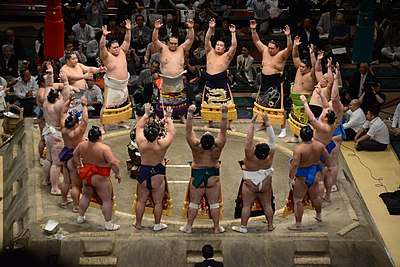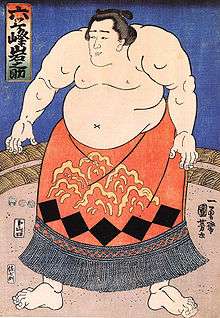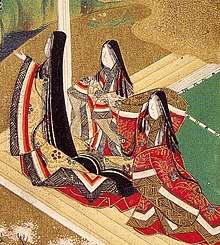Mawashi
In sumo, a mawashi (廻し) is the belt (loincloth) that the rikishi (or sumo wrestler) wears during training or in competition. Upper ranked professional wrestlers wear a keshō-mawashi (see below) as part of the ring entry ceremony or dohyō-iri.
Mawashi

For top ranked professional rikishi, it is made of silk and comes in a variety of colours. It is approximately 30 feet (9.1 m) in length when unwrapped, about two feet wide and weighs about 8 to 11 lb (3.6 to 5.0 kg). It is wrapped several times around the rikishi and fastened in the back by a large knot. A series of matching colour, stiffened silk fronds, called sagari are inserted into the front of the mawashi.[1] Their number varies from 13 to 25, and is always an odd number. They mark out the only part of the mawashi that it is illegal to grab on to: the vertical part covering the sumotori's groin, and if they fall out during competition the gyōji (referee) will throw them from the ring at the first opportunity.
Sometimes a rikishi may wear his mawashi in such a way as to give him some advantage over his opponent. He may wear it loosely to make it more difficult to be thrown, or he may wrap it tightly and splash a little water on it to help prevent his opponent from getting a good grip on it. His choice will depend on the type of techniques he prefers to employ in his bouts. Thus a wrestler preferring belt sumo will usually wear it more loosely, while those preferring pushing techniques will tend to wear the mawashi more tightly.
Many rikishi are superstitious and they will change the color of their mawashi to change their luck. Sometimes a poor performance will cause them to change colors for the next tournament, or even during a tournament, in an attempt to change their luck for the better. An example of this was done by Ōnoshō during the 2020 July tournament, when after several loses in a row, he decided to change from a carmesi color to a dark gray one.
Rikishi only wear the silk mawashi during competitive bouts either during ranking tournaments or touring displays. During training, a heavy cotton mawashi is worn. For senior rikishi in the top two divisions (the so-called sekitori), this belt is coloured white, and it is worn with one end distinctively looped at the front. Sagari are not worn during training.
Rikishi ranked in the lower divisions wear a black cotton mawashi both for training and in competition. In competition cotton sagari are inserted into the belt, but these are not stiffened.
Amateur sumo wrestlers are expected to wear a white cotton mawashi without the looping accorded to the senior professional's training garb.
If a wrestler's mawashi comes off during a tournament bout, he is automatically disqualified.[2] This is extremely rare, but it did occur in May 2000 when sandanme wrestler Asanokiri was embarrassed during a match with Chiyohakuhō.[3] However, for most of sumo's history, whether or not a wrestler's mawashi came off during a bout was considered irrelevant, and the policy of disqualification only came into place when Japan began adopting European attitudes towards nudity.[3]
Keshō-mawashi

Wrestlers in the two upper divisions, makuuchi and jūryō, are allowed to wear a second ceremonial keshō-mawashi during their ring entering ceremony. The silk 'belt' opens out at one end into a large apron which is usually heavily embroidered and with thick tassels at the bottom. The keshō-mawashi may advertise the produce of a sponsor of the rikishi (for example Bulgarian ōzeki Kotoōshū was sponsored by a Japanese brand of yogurt, "Bulgaria", which was prominently displayed on the front of his keshō-mawashi) or be a gift from one of the rikishi's support groups. Alternatively, some foreign-born rikishi (such as Czech-born Takanoyama) bear their national flag on their keshō-mawashi. Popular rikishi may be given many of these keshō-mawashi.
Yokozuna have matching sets of three keshō-mawashi, with two being worn by his wrestler assistants (his tachimochi and tsuyuharai) during his ring entrance ceremony.
In the Edo period the keshō-mawashi also served as the wrestler's fighting mawashi. However, as the aprons become more ornate, eventually the two functions were split apart. In this period wrestlers were normally sponsored by feudal daimyō or overlords, whose clan crest would therefore appear on the keshō-mawashi.

References
- "Success for Japan - The Secrets of Sumo". bccjapan.com. British Chamber of Commerce in Japan. Retrieved 28 October 2019.
- Sharnoff, Lora (1993). Grand Sumo. Weatherhill. ISBN 0-8348-0283-X.
- Kattoulas, Velisarios (20 May 2000). "Exposed:Sumo Wrestler Who Lost It All". International Herald Tribune. Retrieved 2008-05-25.
